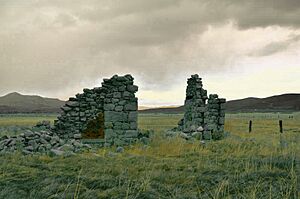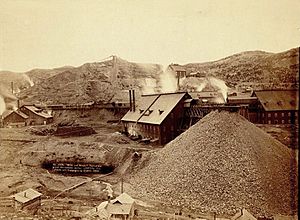George Hearst facts for kids
Quick facts for kids
George Hearst
|
|
|---|---|

Hearst c. 1891 or earlier
|
|
| United States Senator from California |
|
| In office March 23, 1886 – August 4, 1886 |
|
| Appointed by | George Stoneman |
| Preceded by | John F. Miller |
| Succeeded by | Abram P. Williams |
| In office March 4, 1887 – February 28, 1891 |
|
| Preceded by | Abram P. Williams |
| Succeeded by | Charles N. Felton |
| Member of the California State Assembly from the 8th district |
|
| In office 1865–1867 |
|
| Personal details | |
| Born | September 3, 1820 Sullivan, Missouri Territory |
| Died | February 28, 1891 (aged 70) Washington, D.C. |
| Resting place | Cypress Lawn Memorial Park, Colma, California |
| Political party | Democratic |
| Spouse |
Phoebe Elizabeth Apperson
(m. 1862) |
| Children | William Randolph Hearst |
| Profession | Business magnate and politician |
| Net worth | USD $19 million at the time of his death, equivalent to $619 million in 2021 |
| Signature | |
George Hearst (born September 3, 1820 – died February 28, 1891) was an important American businessman, miner, and politician. He grew up on a small farm in Missouri. Later, he became famous for starting many successful mining operations.
One of his biggest achievements was developing the Homestake Mine in South Dakota in the late 1870s. This gold mine worked continuously until 2001. After moving to San Francisco in the early 1860s, Hearst also became a politician. He served as a United States Senator for California. His only son, William Randolph Hearst, became a very famous newspaper publisher.
Contents
Early Life and Education
George Hearst was born near what is now Sullivan, Missouri. His parents were William G. Hearst and Elizabeth Collins. They had three children, and George was raised in a log cabin on their family farm. His father managed three small farms and a local general store.
Public education was not common in Missouri when George was young. So, his schooling was not always regular. But he loved learning about mining. He learned by watching local mines and reading books about minerals. He also spent his free time mining.
Starting a Mining Career

When his father died in 1846, George was 26 years old. He took on the responsibility of supporting his mother, brother, and sister. He also continued mining and running a general store. In 1849, he heard about the California Gold Rush. He waited to make sure the news was true.
In 1850, George joined a group of 16 people and headed to California. They first tried placer mining near Sutter's Mill. This is where miners look for gold in riverbeds. After a tough winter with little gold, they moved to Grass Valley in 1851. Here, they heard about a new type of gold deposit.
Hearst then started looking for and dealing in quartz mines. Quartz mining involves digging into rocks to find veins of gold or silver. For almost ten years, he made a good living as a prospector. He also ran a general store, mined, raised livestock, and farmed in Nevada County.
Big Mining Discoveries
In 1859, George Hearst heard exciting news about silver in Utah Territory. He quickly went to the Washoe district. There, he bought a share in the Ophir Mine, near what is now Virginia City. That winter, Hearst and his partners dug up 38 tons of valuable silver ore. They carried it over the mountains on mules. After it was processed in San Francisco, they made a huge profit of $91,000. This was a lot of money back then!
Later, in 1872, Hearst's friend Marcus Daly told him about the Ontario silver mine in Park City, Utah. This mine helped Hearst through a tough economic time in 1873. It produced $17 million in just 10 years. Hearst and his partners also helped finance Daly's Anaconda mine in Butte, Montana. They also gained a share in that mine.
Major Investments and Business Growth
George Hearst became a partner in a big mining company called Hearst, Haggin, Tevis and Co.. He owned parts of many important mines. These included the Comstock Lode and Ophir mine in Nevada, the Ontario silver mine in Utah, and the Pacific mine in Pinos Altos, New Mexico.
One of his most important investments was the Homestake gold mine in South Dakota. Even though the gold ore was not super rich, the huge amount of gold in the ground kept the mine running until 2001. His company became the largest private mining firm in the United States. George Hearst was known as one of the best experts at finding and judging mining properties on the Pacific coast. He also helped improve how modern mining was done.
George Hearst also bought the San Francisco Examiner newspaper. He accepted it as payment for a gambling debt. He mainly used the newspaper to support the Democratic Party. His son, William Randolph Hearst, really wanted to take control of this newspaper. William Randolph Hearst then used the Examiner to build his huge Hearst publishing empire.
Family and Political Life
While building his mining career, George Hearst supported his family in Missouri. In 1860, he went back to Missouri to care for his sick mother. He also settled some legal issues. During this time, he met Phoebe Apperson again. She was 18 years old and a neighbor. George, who was 42, married her two years later, on June 15, 1862.
That same year, George and Phoebe moved to San Francisco. Their only child, William Randolph Hearst, was born there on April 29, 1863.
In 1864, Hearst was elected to the California State Assembly. He served one term from 1865 to 1866. He was one of 12 members representing San Francisco. His deep knowledge of mines was very helpful. He was chosen for a special committee on mines and mining. Around this time, he bought land in San Simeon, California. This land was later developed by his son into the famous Hearst Castle. The Hearsts also had a home in San Francisco.
George Hearst also owned a stable of thoroughbred horse racing horses. One of his famous horses was Tournament.
Serving as a Senator
George Hearst was chosen to represent California as a Democrat in the United States Senate. He filled a spot that became empty when Senator John F. Miller died. Hearst served from March 23, 1886, to August 4, 1886. In 1886, he was officially elected to the Senate by the state legislature. He served from March 4, 1887, until his death in 1891. As a senator, Hearst worked to reduce the power of the Central Pacific Railroad in American business.
Death and Lasting Impact
George Hearst passed away at age 70 in Washington, D.C., on February 28, 1891. The California Legislature and state courts closed so officials could attend his funeral.
When his wife, Phoebe Apperson Hearst, inherited his wealth, she used a lot of it to help start new libraries at several universities. George Hearst is buried in Cypress Lawn Cemetery in Colma, California. His wife and son were later buried there too.
The Hearst Memorial Mining Building at the Berkeley campus is named after George Hearst. It honors his contributions to mining. In 1996, he was recognized in the Hall of Great Westerners at the National Cowboy & Western Heritage Museum.
See also
 In Spanish: George Hearst para niños
In Spanish: George Hearst para niños
- List of United States Congress members who died in office (1790–1899)




